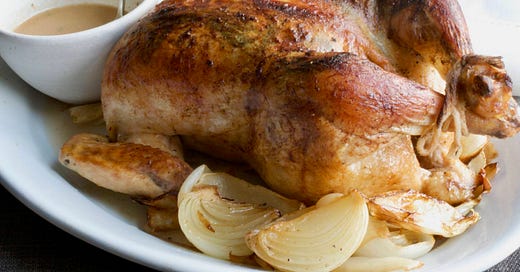I count a simple roast chicken as one of my dinner standbys, whether it’s for just us or for a small dinner party. Among the carnivores I know, there isn't anyone who doesn’t love roast chicken (OK, OK, I have one friend who won't eat “anything with feathers”). A roast chicken is homey—but somehow elegant at the same time—and always satisfying, especially for bone nibblers (I’m looking at you, Steve).
However, it has come to my attention that not everyone shares my view that this is a no-brainer dinner that anyone can make. Here’s the thing—there are a lot of roast chicken recipes out there, and they’re probably all a little different, and they all work. This is largely due to the fact that you don't really need a recipe to make a roast chicken—more like guidelines. At its very simplest, a roast chicken just needs to be seasoned with salt and pepper, slicked with some olive oil or butter, and put in the oven to roast for about an hour and a half (give or take). You can use a sheet pan covered with foil if it’s the cleanup that you’re afraid of; you don't need a roasting pan or rack.
Or maybe it’s touching a raw chicken that creeps you out? I know, it is a little creepy, but you just need to man up for about five minutes and you’ll get through it. I keep latex gloves handy in my kitchen—mainly for handling hot peppers, or sometimes beets, etc. But if you’re that person that doesn’t want to cook chicken because you’ll have to touch it first, try wearing gloves!
Or maybe you’ve been scared off by the thought of potentially spreading salmonella around your kitchen? First they tell you to rinse the chicken! Then they tell you NOT to rinse the chicken! These warnings are there to make you more aware that you COULD spread bacteria around your kitchen (though you most likely will not). Not rinsing is a way to minimize this risk, but not eliminate it. But I’ll tell you a secret: I still rinse my chicken most of the time. I’m really careful about it. I move my sponge out of the way first, and I make sure there are no vegetables that won't ultimately be cooked nearby (like salad greens). Then I clean my sink afterward with a bleach-based cleaner. I have a few more tips on this subject that I’ll share with you in a video that you’ll get on Friday. Let me also mention that I have cooked and handled A LOT of chicken and have never gotten food poisoning. EVER. This doesn’t mean you shouldn’t be careful, just that you shouldn’t be SCARED.
OK, now that we have that housekeeping out of the way, let’s get back to golden brown, crispy, aromatic chicken. As I was saying, I roast a chicken often—usually weekly in fact. For just the two of us, it provides dinner and typically a couple of lunches—and sometimes another dinner! This is obviously a huge bonus. Whether a single chicken will serve four depends entirely on the white meat/dark meat preference in your household. Usually it works out that half the people prefer dark, and half white, but if you’re making roast chicken for guests, either check on their preferences, make two chickens, or opt for a larger chicken. If you can find one, a 5-pound chicken will yield a lot more meat than the standard 3 ½-pound chicken, and take just a little longer to cook. It’s also harder to overcook and dry out.
On Friday, I’m going share two of my favorite recipes for more advanced versions of roast chicken. One of them relies on one of my go-to methods: marinating the bird first in a flavorful yogurt or buttermilk-based mixture, which not only flavors the bird well, but also makes it extra juicy. Stay tuned! Today, I’m sharing my gold standard recipe for roast chicken, which I use most often in my own home and hope that you’ll come back to time and time again.
Do you have any special requests?
Is there a certain cooking technique or ingredient you’d like me to focus on in an upcoming newsletter? As I map out Susanality content for the spring and beyond, I’d love to hear any special requests or topics you’d like to see covered—whether it’s a particular French cooking technique, a nostalgic dish from your childhood you’d like to recreate, or a certain seasonal ingredient you want to celebrate. Or maybe you’d like more styling content—or even tips for photographing food? Are you here mainly for the sweets? Comment below or email me any requests you have!




